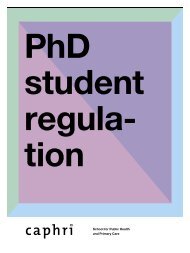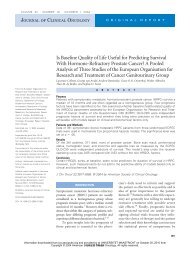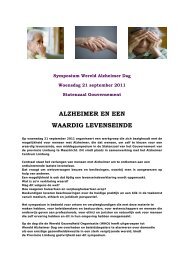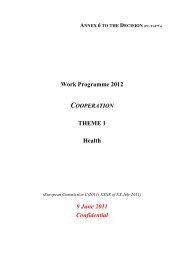Are Psychotic Psychopathology and Neurocognition ... - Caphri
Are Psychotic Psychopathology and Neurocognition ... - Caphri
Are Psychotic Psychopathology and Neurocognition ... - Caphri
Create successful ePaper yourself
Turn your PDF publications into a flip-book with our unique Google optimized e-Paper software.
PSYCHOTIC PSYCHOPATHOLOGY AND NEUROCOGNITION161nicity of illness (in years), (b) mean age, <strong>and</strong> (c) percentage ofmen. It was hypothesized that studies that included more chronicallyill or older or male subjects would show stronger associationsbetween cognition <strong>and</strong> symptoms (Dikeos et al., 2006; Murray etal., 2005; Schultz et al., 1997; Simonsen et al., 2007). We examineda fourth moderator for the positive dimension that indicatedwhether the positive subscale included any symptoms of disorganization,as this had been done in the older studies in particular.Inclusion of symptoms of disorganization in the positive subscalewas expected to increase the correlations with the cognitive domains(Liddle & Morris, 1991; Nieuwenstein et al., 2001).We used a mixed-effects model to examine the influence of themoderators on the average correlation within each psychosisdimension–cognitive domain combination. The amount of residualheterogeneity was estimated with the method of moments estimatoron the basis of weighted least squares (Raudenbush, 1994).Because information about some of the moderator values withinthe studies was missing, we decided to examine each moderatorindividually (instead of including all moderators simultaneouslywithin a single model). Results are expressed in terms of theestimated regression coefficient ˆ <strong>and</strong> indicate by how much theaverage correlation (in the transformed units) is estimated tochange with a 1-unit increase in the moderators. For age <strong>and</strong>chronicity of illness, 1 unit means 1 year; for men, 1 unit means1%; <strong>and</strong> for positive–disorganized, 1 unit means going from (0)positive symptoms to (1) positive <strong>and</strong> disorganized symptoms. Thecorresponding 95% CI for the true regression coefficient is givenalso. Because the r-to-z transformation is nonlinear, one cannoteasily back-transform the slope of the regression coefficient intothe raw correlation metric.Third, within each of the cognitive domains, we examinedwhether the average correlation coefficient differed between thenegative <strong>and</strong> disorganized dimensions, in order to further clarifythe controversial issue of differential patterns of cognitive impairmentrelated to both (Liddle, 1987; Nieuwenstein et al., 2001).Because numerous samples/studies contributed correlations betweena particular domain <strong>and</strong> both dimensions, we had to accountfor the dependencies between multiple correlations from a singlesample. We estimated the covariance between two r-to-z transformedcorrelations from a single sample using Equation 10 givenby Steiger (1980) <strong>and</strong> replaced parameters with their correspondingsample estimates where necessary. In doing so, we had toestimate the correlation between the two dimensions on the basisof previous literature (none of the studies reported these correlations).For this analysis, the correlation between the negative <strong>and</strong>the disorganized dimension was estimated at .39 (Peralta, Cuesta,& de Leon, 1994). Sensitivity analyses were conducted using twoother assumed correlation values (i.e., .20 <strong>and</strong> .60).Fourth, in order to deal with potential overlap in the samples inthe three previous steps of the statistical analyses, we conductedsensitivity analyses that excluded the smallest studies of each pairwith an uncertain degree of overlap, as discussed before.ResultsOf the 3,129 studies produced by the search, 187 were consideredeligible for inclusion. Of these, 129 were excluded, because(a) the study examined associations with single symptom items(3.1% of the total number of studies not included); (b) the studysplit the subject sample into groups on the basis of their score onthe different clinical scales (27.9%) or on the basis of their cognitiveperformance (6.2%) <strong>and</strong> reported the associations with thesegroups; (c) the study reported only correlations that were statisticallysignificant (24%); (d) the study used neuropsychologicaltasks that were not used in any of the other included studies or thatcould not be classified under one of the cognitive domains (24%);(e) the study reported global cognitive or psychopathology scores(2.3%); (f) the study sample completely overlapped with a largerstudy that was included (2.3%); or (g) the authors did not reply tothe request to provide additional data (10.1%).The literature search thus yielded 58 studies that evaluatedpsychosis dimensions <strong>and</strong> cognitive performance in patients with alifetime history of nonaffective psychosis, according to st<strong>and</strong>ardizedneuropsychological instruments. These studies are listed inTable 2, along with the sample sizes <strong>and</strong> the main sample characteristics.In total, 5,009 individuals with a diagnosis of nonaffectivepsychosis contributed to this meta-analysis. The patientswere 72.7% men (reported by 57 articles). The mean age of thepatients ranged from 19.1 years to 51.9 years (reported by 55articles). Mean chronicity of illness ranged from 4.8 years to 28.9years (reported by 37 articles). The mean age of illness onsetranged from 18.6 years to 26.23 years (reported by 18 articles).The mean years of education ranged from 9.9 to 13.7 (reported by39 articles). A total of 58% of the subjects were inpatients (reportedby 44 articles). Of the patients, 94% were diagnosed withschizophrenia, 3% with schizoaffective disorder, <strong>and</strong> 3% withdelusional <strong>and</strong> other psychotic disorders (reported by 55 articles).Other variables, such as level of symptoms, dosage of antipsychoticmedication, percentage of patients on typical versus atypicalmedication, <strong>and</strong> number of prior psychotic episodes, may berelevant for the association between symptoms <strong>and</strong> cognition butwere reported by too few studies. A table with all data points is notpresented, due to space constraints.Meta-Analyses of Correlations Between CognitiveDomains <strong>and</strong> Psychosis DimensionsResults for the meta-analyses are shown in Table 3 (for visualrepresentation, see Figure 1). Both the negative <strong>and</strong> the disorganizeddimensions were significantly <strong>and</strong> negatively correlated withthe majority of the nine cognitive domains, with averaged correlationsin the order of .29 to .12. The largest effect sizes(estimated correlation higher than .2) were for verbal fluency,verbal learning <strong>and</strong> memory, <strong>and</strong> IQ in the negative dimension <strong>and</strong>for attention/vigilance, visual learning <strong>and</strong> memory, <strong>and</strong> IQ in thedisorganized domain. The correlations with the positive dimensionwere neither large nor significant, except for a negative correlationwith the domain of speed of processing ( ˆ 0.089; 95%CI 0.164 to 0.012), which indicated that worse performancewas associated with a higher level of symptoms. For the analysisof the depressive dimension, none of the correlations were eitherlarge or significant; however, five or more observations wereavailable for only three cognitive domains.Regression Test for Funnel Plot AsymmetryNone of the regression tests for funnel plot asymmetry weresignificant for the 36 pairs of psychosis dimensions <strong>and</strong> cognitive







